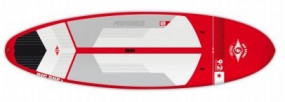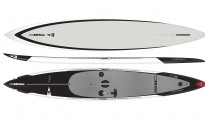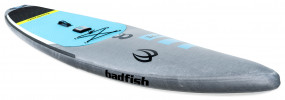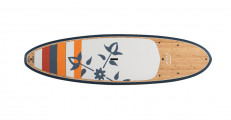Paddleboard surfing incorporates aspects of both traditional surfing and flatwater SUP. In the early 2000s, big-wave surfer and new fitness guru Laird Hamilton helped make surfing with standup paddleboards cool, using the power of a paddle and buoyant speed of paddleboards to catch waves on days when the break wasn’t big enough for prone surfing.
Surf paddleboards can be used to ride breaks wherever surfboards are used, but they also work well on the Great Lakes and areas where waves are small or infrequent. River surfing, a further cross between flatwater paddleboarding and whitewater paddling, continues to gain popularity as river SUP design evolves. Inflatable surfing SUPs are often used on rivers as they are more forgiving when they hit submerged obstacles.
Surf paddleboards are typically shorter than regular paddleboards, often nine feet or less. They resemble a traditional surfboard, with an upturned, rounded nose, but are typically wider, for the extra stability.
This page will help you find your next surf paddleboard. You will find advice for buying new and used boards, as well as answers to common questions that arise. Along the way, you’ll find links to our Paddling Buyer’s Guide where you can view, compare and shop for the best SUPs for surfing.
Top picks: Best surf paddleboards for 2024
The following surf paddleboards have received the highest star ratings by reviewers in our Paddling Buyer’s Guide. See and review all surf paddleboards here.
Best Surf Paddleboards

Wayfarer
Shop surf paddleboards
Our Paddling Buyer’s Guide is a great resource to start searching for your next surf paddleboard. A range of different surf-style paddleboards are on the market. Whether they are designed for ocean waves, for river surfing or for mixing in some flatwater sessions, you can find the boards here.
Clicking on the specific board provides information on specs, prices, reviews and links to buy them.
Shop by type
Shop by brand
Shopping for a used surf SUP?
If you are looking to maximize your budget, a used surf SUP can be a great option. Some things that are important when looking for used boards is how they were used, where they were used, and how they were stored.
How the board was used
If the surf SUP was part of a rental fleet, expect the worst—rentals are often used and transported by inexperienced surfers. If you are just looking for a ‘beater’ board, that may be fine, but prepare yourself to be working on repairs down the road. Thoroughly inspect the board for dings and dents and try it out if you can.
Where the board was used
Looking at where the seller is located and chatting with them about their history on the board may give you an idea of where the board performs best or meets its limits. Compare them with your own surfing level—but be honest. If you are a total beginner, buying a board that outpaces your skill level may mean you’re spending more time swimming rather than surfing.
How the board was stored and transported
Look for dents on points where the board may have been tied too tightly to vehicle racks. If the board was left outside, the side which faces up will show significant fading. UV weathering can drastically decrease the life of a paddleboard and compromise the structural integrity of the board.
For more tips on what to look for when selecting a used paddleboard, read our article How To Buy A Used Paddleboard.
Surf paddleboard buying guide
Are you looking to find the best SUP for surfing? It is easy to get lost in the wash of buzzwords surrounding the various boards available. The first thing to consider is the size of paddleboard you are looking for. SUP surfboards will often be shorter than nine feet, but some surf-style boards can be up to 11 feet.
Fins, leashes and paddles are important parts of the paddleboard kit as well. Be sure to leave space in your budget for these if they are not included with the board purchase.
Some boards are sold with fins included, while others require they be bought separately. Surf paddleboards typically have either one or three fins. A one-fin setup consists of a large fin in the centre of the tail. This helps the board to track while still allowing it to turn easily. Think of old-school longboarders making slow, graceful bottom turns on waves. Three-fin setups have the same center fin, but with the addition of two smaller “thruster” fins on either side.
Some, like Lisa Schell of PaddleMonster.com, argue that it is better to buy a high-end paddle and a mid-range board than the opposite. The reason behind this is that a paddle often stays with you, as you upgrade boards down the road. A high-performance surf paddle will help maximize your sessions.
A leash is an essential safety item. It is your connection to the board, which when surfing, is a valuable safety device. Make sure it is comfortable and fits properly. To accommodate the board length, SUP leashes are often at least 10 feet long.
-
What is a SUP surfboard?
A standup surfboard is a paddleboard specifically designed for surfing. These boards are shorter than all-around paddleboards and have lots of rocker, especially in the nose of the board. SUP surfboards have a planing hull, meaning they will skim across the top of the water rather than slicing through it (up to a point) like the displacement hulls found on touring paddleboards.
-
Can a paddleboard be used for surfing?
If the waves are right, any paddleboard can catch a wave. Some boards, specifically designed for surfing, will catch them better than others due to design tweaks on the board. They may be marketed as such, but also look for some telltale signs that the board will be happiest on a wave. A shorter length, and a wide, upturned nose trimming into a narrow tail are indicative of SUP surfboards.
-
Paddleboard vs surfboard
Can you use a paddleboard for surfing? Yes! Stand-up paddleboards can be used for surfing, although catching a wave while already standing up requires a different approach than prone surfing. Many assume it will be much easier because using a paddleboard eliminates the dreaded ‘pop-up’ moment which beginner prone surfers get hung up on.
Surf-style paddleboards are wider, with a higher volume than a surfboard. This makes them easier to balance on, but paddling out and pivoting the board demands strong flatwater paddling skills. They will often resemble hard-top surfboards, with an epoxy or fiberglass construction around a foam core. Inflatable surf-style paddleboards also exist, and although they are best suited for river surfing, they can also be used on open water.
Surf paddleboards can be used on flatwater as well, but they may feel slower than touring boards.
-
SUP size for surfing
Selecting the appropriate size of surf paddleboard depends on your size and skill as well as the waves you will be surfing. For a specific surf SUP, size charts are a good tool to gauge the best size of board for your height and weight. Beginners will appreciate the added buoyancy and stability that comes with a bigger board, while smaller boards are better for more experienced SUP surfers.
Surf paddleboard reviews
Reading paddleboard and SUP surfboard reviews is a good way to understand where certain boards excel. Read the reviews to see if a board you may have in mind matches your ideal paddling and surfing style.
Coming soon










-first_product_boats.jpg)

